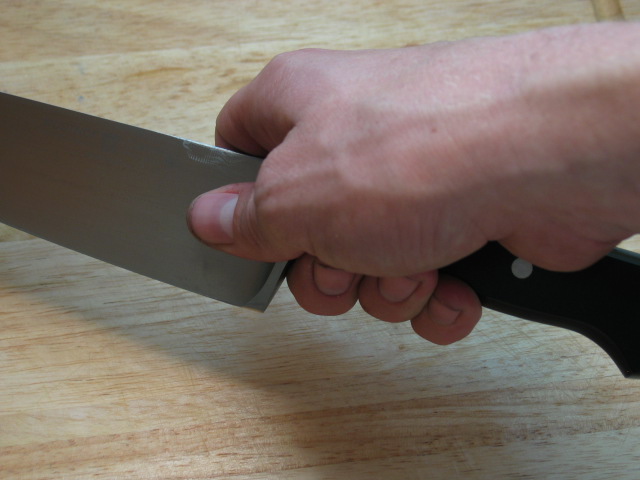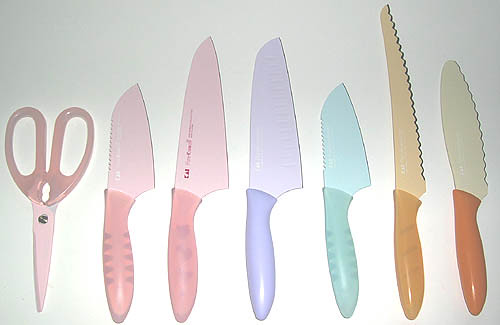Its sort of obvious, but no matter the style of cookery that you're going to deal with, you're bound to have to use knives. And one place where its easy to screw up, its with knives. Allow me to explain.
To begin, we go with the basis that you're poor, so you have limited resources. With any bit of luck, you may have had some blades handed down to you by an aunt*. Whether you were handed a good or bad knife, chances are, you haven't really taken care of it all that well, and you might well be more acquainted with the act that is professionally referred to as "hacking", rather than, say chopping, slicing, or even pealing. This is not exactly your fault; after all, you most likely were never taught how to do this properly, so you had to guess how its done, a scary proposition when dealing with anything sharp and your digits.
So then, how do you pick the right sorts of knives then? Its pretty daunting when you go to a kitchen supply store (or even a department store) with its large selection of knives for different tasks, and at a range of price that can reach stratospheric (some chefs have their blades hand forged by master smiths...)
Upfront, you need three basic knives. Yes, just three. If you're just starting, you really don't need a boning knife, or a fancy sashimi blade. They have their uses, but they are NOT basic tools.
First, you need a large one
a small one
and a serrated edge one.
That's it.
The large knife, which is commonly referred to as a chef knife, is a solid tool with a blade around eight inches in length. You can very well substitute the French style for a Chinese cleaver. It looks unwieldy, but is surprisingly agile. An added advantage is that it is very inexpensive, coming in at the ten to fifteen dollar range. They can get and stay very sharp, as they are generally made of carbon steel, making them easy to sharpen. However, they are very prone to rust and stain at the contact of acidic juices, so they need a bit more care.
The small knife is a utility knife, a very versatile tool indeed. I would highly recommend that you stick to stainless steel for that one. It is also referred to as a parring knife, as it is often used for that purpose. The serrated edge knife is your good, old-fashioned bread knife.
There are certain things that you will want to pay attention to when choosing a knife. First off, how solid is it? A good blade for a large knife has to be relatively thick at the back, gradually thinning out towards the edge. A knife that is pretty much a sheet of steel with an edge as its use, mostly as a slicer, but that's not necessary right not. You need a solid, thick-backed blade to have enough power to cut tough roots like rutabagas, cut cabbage in half, or cut squashes down the middle. You also need to be able to brace your hand along the back to maintain control of the blade.
If its heavy enough, you can also use to back in a hammer move to break certain tough shells or bones.
Utility knifes don't require this as much, as they are used for more delicate work, or small slicing jobs. Whatever knife you use tho you need a design that makes sure that you'll be able to maintain a good grip on the handle if things get rough. You want something of a guard.
You'll want that design feature when your hand and handle are slick with meat juices and grisly with fats. The large knife's blade has to be wide enough that your knuckles wont hit the cutting board when you chop. It also makes sure that the blade wont slip and slice your fingers if its slippery.
Where the problem really lies in the end is the price. If you had to invest in a single good knife, then the chef's knife is the one to splurge on. With even the minimum of care it will last you a lifetime if you pick a good one. The Chinese cleaver combines low price, ease of use and solid design, but comes at the price of extra care and maintenance.
It is a personal preference, but regardless of what some professional chefs use, I avoid those shaped plastic handled knifes as far as the chef's knife is concerned
For the backbone of my knives, I want the traditional bastard, the one that clearly shows that it is full tanged
which means that the steel extend all the way down the handle to the butt. This ensures that it wont break on you if you happen to crack the handle piece.
And at last, get one of those:
And learn how to use it properly. For this, I'll let Gordon Ramsay show you in a little video: how to sharpen a knife. Later on, I will post some reference books that will include such instructional.
Keep you blades sharp, keep them clean, store them safe. Wrap them in a kitchen towel before storing them away if needed be.
Stay tuned for the next installment. Its such a surprise that even I don't know what its going to be!
*Thrifter's tip: the day you decide to leave the nest, let out the word that you need kitchen stuff, especially in the family. Its surprising the amount of tools and pots and pans that you'll end up with. With a bit of knowledge on your side, you might just be able to score a few good hits amongst those discarded toys, and if anything, you just got yourself some free dishes!








No comments:
Post a Comment